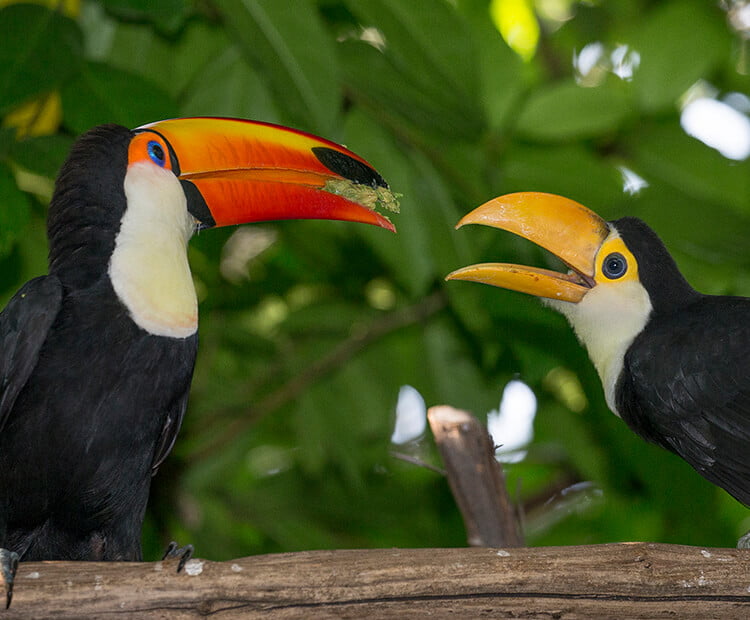Enter the Wonderful World of the Toco Toucan: A Wildlife Explorer’s Guide

What is a Toco Toucan?
The Toco Toucan (Ramphastos toco) is the largest species of toucan. It is a unique looking bird that lives in the rainforests of South America.
Table of Contents
ToggleIntroduction to the Toco Toucan
Toco Toucans are black in color with a white throat. They have bright orange bills that can grow over 8 inches long! That’s about one third of their whole body length. Their bills may look heavy, but they are actually very lightweight since they are made of keratin, the same protein that makes up hair and fingernails.
Toco Toucans use their big bills to reach fruit high up in the rainforest canopy. They also use them to peel fruit once they’ve plucked it off the trees.
Characteristics of the Toco Toucan
- Large black body with a white throat
- Bright orange bill that is very lightweight
- Bill length is about 8 inches long
- Total body length is around 25 inches
- Weigh between 400-500 grams
Important Facts About the Toucan Family
- There are over 40 different species of toucans
- They are part of the bird family Ramphastidae
- Toucans live in Central and South America
- They move by hopping and fly by alternating flapping and gliding
The Toucan’s Brightly Colored Bill: A Unique Trait




The Toco Toucan’s bill is its most unique feature. Their bright orange bills help them find mates and stand out.
Toucan bills grow proportionally as the birds mature. Baby toucans hatch with tiny bills that grow larger as they develop.
The bill’s bright colors come from blood vessels underneath the keratin exterior. By regulating blood flow to their bills, toucans can control the intensity of the colors.
The Habitat of Toco Toucans: Where Toucans Live

Toco Toucans make their home in the rainforest canopies of South America. More specifically, they live in:
- Tropical forests
- Savannas
- Woodlands
- Shrublands
They prefer semi-open habitats with scattered trees. This allows them to move easily between trees.
Toucans are non-migratory. They may make small local movements within their home ranges to follow food sources.
>> Related Article: Birds in Amazon Rainforest
Behaviours and Characteristics of the Toco Toucan
The Croaking Sound: A distinct feature of a Toco Toucan’s call
The Toco Toucan has two distinct vocalizations – a croaking sound and a rattling call. The croaking sound is lower-pitched and often used as an alarm call to alert other toucans of potential danger. It is produced by both male and female toucans. Toucans may croak back and forth to each other as a form of communication.
Role of Toucan’s large bill in its survival
The Toco Toucan’s oversized, colorful bill plays several key roles in its survival:
- Grasping and eating fruit. The serrated edges help peel fruit skin.
- Catching insects and eggs to supplement its diet.
- Regulating body temperature. Toucans can adjust blood flow to the bill to release excess heat.
- Camouflage and defense. The bright colors blend into dappled light in treetops. The large bill can be used to fend off smaller predators.
- Attracting mates.
The Toco Toucan diet: Are Toco Toucans frugivores?
Toco Toucans are omnivores but fruit makes up the majority of their diet. Their favorite fruits include figs, oranges, guavas, and peppers. They also eat insects, eggs, and nestlings to obtain more protein while breeding. So while not pure frugivores, their diet is heavily fruit-based.
Toco Toucans and the art of sharing fruit
Mated pairs of Toco Toucans have courtship rituals of passing fruits and treats back and forth between their large bills, with the male offering food gifts to the female. Toucans also regurgitate food to feed their hatchlings in the nest. So fruit sharing plays an important social role in Toco Toucan pairs and families.
How Toco Toucans use their beaks to dig deep into tree cavities



Toco Toucans use their large, serrated-edged bills to reach deep into tree cavities for several purposes:
- To grab eggs and nestlings from the nests of other birds to eat. The long bill allows them to access nests deep inside cavities.
- To dig out and clear debris from their own nesting cavities. Toucans excavate and build nests inside tree holes, using their bills to clear space and widen the cavity.
- To forage for fruit and insects deep inside tree holes that are inaccessible to other birds. Their bills allow them to exploit food sources other birds cannot reach.
- To peel back bark and excavate into trees to create nesting cavities. Their bills have some wood-excavating ability to carve out nesting sites.
The Toco Toucan uses its large bill like a digging tool to exploit deep tree cavities for nesting, foraging, and predation in ways that other tropical birds are unable to match. The bill’s size and serrated edges are adaptations for excavating, grasping, and extracting items from deep inside tree holes and crevices.
Reproduction and Life Cycle of Toco Toucans
The Breeding Season of the Toco Toucan
- Toco toucans have a breeding season that occurs in the spring, typically between March and July.
- The exact timing differs across their range from central to South America. In some regions, breeding starts as early as February, while in others it begins in June.
- Prior to breeding, male Toco toucans will offer food gifts to potential mates. If accepted, the female will reciprocate by passing food back and forth, which helps cement the pair bond.
Description of a Toco Toucan’s Nest and Role of Both Male and Female
- Toco toucans nest in holes and cavities in trees, often moving into old woodpecker nests.
- Both the male and female participate in preparing the nest. They use twigs, leaves, moss and fruit pulp to line the cavity.
- The female lays 2-4 white eggs. Both parents take turns incubating the eggs for 17-18 days before they hatch.
- The male and female share parental duties, taking turns feeding and caring for the hatchlings.
From Egg to Chick: The Life of a Toco Toucan’s Early Days
- Baby Toco toucans hatch from the egg naked, blind, and helpless after 16-18 days of incubation.
- For the first few weeks, the hatchlings are completely reliant on their parents for food and protection as they grow feathers and open their eyes.
- At first, the parents feed the chicks mostly insects. As they grow older, more fruit is incorporated into their diet.
- After about 6-8 weeks, the young toucans will fledge and leave the nest cavity.
How Toco Toucans Raise Their Chicks in Tree Cavities
- Toco toucans are caring, attentive parents who regularly feed and clean the nest during the chick rearing phase.
- The cavity nest provides safety for the vulnerable chicks. Both parents stand guard and chase away potential predators.
- As the chicks grow, their distinctive large, colorful bills start to develop, allowing them to begin eating fruit.
- Parents continue to supplement the young toucans’ diet by regurgitating fruit and bringing additional insects and small vertebrates.
The Growth Journey of a Toco Toucan from Chick to Adolescent
- For months after fledging, the young toucans will be attended by their parents, who show them good feeding trees.
- The juvenile plumage is duller than the adults. Their iconic bills grow slowly over the first year, not reaching full size until maturity.
- Young toucans reach sexual maturity between 3-4 years old. After the first year with their parents, they become independent.
- Adolescent Toco toucans may join small flocks of other juveniles and subadults, learning social dynamics before pairing up to breed.
Toco toucans have a defined breeding season in the spring months. They nest in tree cavities, with both parents sharing incubation and chick rearing duties. From hatching to fledging takes 6-8 weeks, after which the young are fed and accompanied by their parents for up to a year as they slowly mature and develop their adult features.
Conservation Status and Threats to the Toco Toucan
The Toco Toucan and the Red List: Current conservation status
The Toco Toucan (Ramphastos toco) is listed as a species of Least Concern on the IUCN Red List of Threatened Species. This means it is not currently considered threatened or endangered. The large range and ability to adapt to human-altered habitats contribute to its Least Concern status.
However, while not threatened as a whole species, Toco Toucan populations are generally decreasing across their range. Local declines and extinctions may become an issue in the future if threats are not properly managed.
The problem with pet trade and its effect on Toco Toucan populations
The pet trade poses one of the biggest threats to Toco Toucans. A 2023 study found Toco Toucans were the second most commonly traded toucan species internationally, making up 19% of the global toucan trade.
Toucans are popular as pets due to their bright colors, intelligence, and often affectionate nature when hand-raised. However, removal of chicks from the wild can negatively impact wild populations over time. Additionally, captive toucans often die prematurely from improper care and diet.
Mentions of Toco Toucans at the San Diego Zoo



The San Diego Zoo participates in the Toco Toucan Species Survival Plan and successfully hatched Toco Toucan chicks in 2017 for the first time in over 30 years. The twin chicks and their mother are on exhibit in the Zoo’s Parker Aviary for guests to observe.
The threats that Toco Toucans might face in their habitats
Deforestation is the biggest threat to Toco Toucans in the wild. Their rainforest habitat continues to be logged and converted for cattle ranching, soy production, infrastructure development and other human uses. This habitat loss decreases available nesting cavities and food sources.
Hunting for meat and feathers also threatens populations in some areas. Even where hunting is illegal, enforcement is often lacking.
Additionally, natural predators like forest eagles, owls, boas and jaguars take their toll, especially on vulnerable chicks and eggs.
Initiatives taken to preserve the Toco Toucan species
Several conservation groups work to protect Toco Toucans, including BirdLife International and the San Diego Zoo Wildlife Alliance. These groups aim to preserve rainforest habitats, curb illegal hunting and trade, and maintain captive populations as an insurance population.
Additionally, the Toucan Rescue Ranch in Costa Rica focuses on the rehabilitation and research of wild Costa Rican toucans that have been confiscated from the illegal pet trade. Through education and enforced protection, they work to preserve wild toucan populations.







